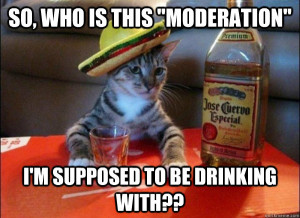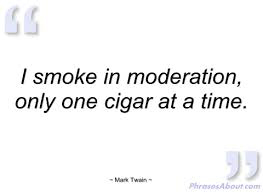In the past two posts I’ve written about collectors and artists “From Hell” – the ways they can be high maintenance people . . . to the point where I lose patience and don’t want to deal with them. This week I want to talk about the “bright side” of what I do. Because while those difficult people exist, they aren’t anywhere near the majority….and even those who are “difficult” can be shown the error of their ways. 🙂 So, with that in mind, what makes for the “perfect” client, whether it’s someone I’m selling art for (artist or collector or estate), or someone I’m selling art to?
TEMPERANCE
Probably #1 on my list of characteristics I cherish in buyers and sellers alike, is moderation and self-restraint.

Too many artists, and too many collectors, to my way of thinking, have what I call an intemperate relationship with their art, or their hobby. It’s easy for both groups to be too easily guided by their emotions; to be immoderate, unrealistic, and self-indulgent when it comes to their “passion” – whether it’s a passion for creating art, or acquiring it.
Artists who can’t be objective about what they create, or their talents, are setting themselves up for failure. Not every creation is a masterwork. Not every painting is sacred. Plus, tastes in contemporary SF art change over time, and the market responds to those changes. Artists who keep up, who network, who maintain in close contact with industry professionals are less prone to succumb to the “Diva” role that we love to see artists take on – but which (at the end of the day) we can’t deal with. “Artistic temperaments” are great in theory, but not in practice – trust me on that!
 I realize that rationality and logic can be difficult goals here. Many Artists have access, probably to an extent they didn’t wish for, nor want, to the excessively emotional content of their lives. That access can be self-destructive – even though it’s that very access that also enables them to be “in touch” with themselves in ways which frees them to express those emotions as they do; to totally filter them out, or (at the extreme) suppress them would essentially rob them of their ability to make a living. So it’s no easy feat for them to channel those emotions into productive behavior. I get that. I also get the need to retain the kind of “childlike wonderment” that provides the spark for creativity. But at some point, eccentricities cross the line from being endearing and amusing to becoming frustrating and off-putting to others.
I realize that rationality and logic can be difficult goals here. Many Artists have access, probably to an extent they didn’t wish for, nor want, to the excessively emotional content of their lives. That access can be self-destructive – even though it’s that very access that also enables them to be “in touch” with themselves in ways which frees them to express those emotions as they do; to totally filter them out, or (at the extreme) suppress them would essentially rob them of their ability to make a living. So it’s no easy feat for them to channel those emotions into productive behavior. I get that. I also get the need to retain the kind of “childlike wonderment” that provides the spark for creativity. But at some point, eccentricities cross the line from being endearing and amusing to becoming frustrating and off-putting to others.
“Crazy collectors” have the same problem, and can develop extreme and very uneasy relationships with their hobby. Like junkies, they gotta get their next “fix,” an ephemeral “high” that dissipates as soon as the artwork is up on the wall. Or they go into debt chasing down the one “killer piece” that they must have, or feel like a failure. At some point, enjoyment can cross the line into  obsessiveness. The collector who jokingly says to me “I’ve just spent my child’s first year at college on art” is a collector in need of self-control. Rationality and logic are just as challenging a concept for this group as for “crazy artists.”
obsessiveness. The collector who jokingly says to me “I’ve just spent my child’s first year at college on art” is a collector in need of self-control. Rationality and logic are just as challenging a concept for this group as for “crazy artists.”
Remember Aristotle and You Can’t Go Wrong
MODERATION is the key here, in indulging your appetite for art, or your passion for creating it. Have a sense of humor. Take a breath. Try to get back to the basics of why you are doing what you do: for the joy or it, for the fun of it. Twenty years ago SF/F art collecting was just breaking through as a hobby. Older, vintage paintings were still relatively cheap to obtain, and collectors were not as anxious as they are today, about making their purchases “pay out” in the long run. This only adds a layer of stress and anxiety that detracts from the reason you are buying art in the first place: the enjoyment you can get from collecting art “as a hobby.” Once you start obsessing over the potential market value, or “trade” value, of what you acquire, it’s no longer something you are doing for fun.  Collectors and artists both have the propensity for letting what they LOVE consume them, to the point where there is nothing else in their lives. They only spend their time painting, or hunting for the next piece to buy. This imbalance in life style – focusing on only one aspect of living, at the expense of others – is bound to lead to more resistance from others, than living by the Greek principle “Nothing in Excess.”
Collectors and artists both have the propensity for letting what they LOVE consume them, to the point where there is nothing else in their lives. They only spend their time painting, or hunting for the next piece to buy. This imbalance in life style – focusing on only one aspect of living, at the expense of others – is bound to lead to more resistance from others, than living by the Greek principle “Nothing in Excess.”
Of course, one person’s “moderate” can be another person’s “extreme”. I would be an excellent example of that!

So this is a tricky concept to implement 😉 But I’d like to think that there is more to my life than just ART. After all, I am writing . . . this post! That’s proof, right?










